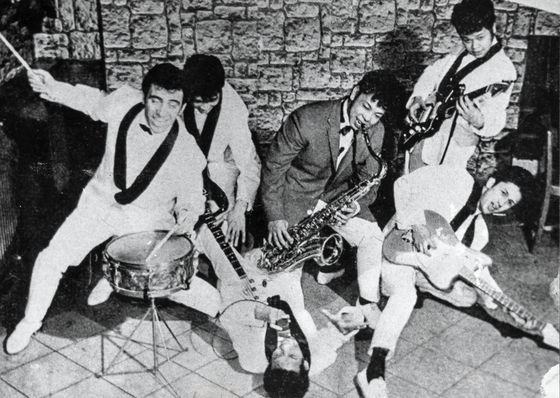by Chris Hyde
What I have to say about the Indonesian bands mainly refers to the late 1950ies and early 1960ies because the Indo rock was already past its peak in 1964 and nobody cared much about what was still going on as the English beat bands flooded the rock’n’roll scene. It was musically simply too perfect, too smooth, too slick and tame. Within the five years between 1958 and 1963, however, they provided us with the hottest rock’n’roll that raged live through the rock clubs and dance bars of that time. The first Indonesians came to Germany by the end of 1958: young exotic foreigners in elegant white shawl collar suits. They used to carry their new-fashioned, board-like guitars low in front of their crotch and indulged in an oddly shimmering, metallic sound, really strange. And when they rocked off and moved across the stage in lockstep, it looked like they were fucking their guitars. The chicks got wet and were really mad about the boys.
I have depicted the appearance of these exotics and their effect on the scene in my book Rock’n’Roll-Tripper. In a minimum of time the early English and local bands were banned from the leading clubs and bars of the garrison towns. It were the Indonesians that dominated the battle grounds at the rock frontier now.
Musical trendsetters were the Tielman Brothers, still active until the late 1980ies, who initially defined the sound and direction of Indo rock with four musicians on double bass, guitars and drums. The Tielmen put on a show that made you forget all other bands that had been on the stages before. In the early 1960ies I still saw them quite regularly in Hanau’s notorious Jolly Bar. One night a fucked up shmock came into the club, marched swankily to the stage and told the boys that they looked like depraved apes. Ponthon, straight-faced and right in the middle of a riff, smashed the head of his new Fender bass into his face and continued playing as the waiters dragged the guy out with a broken jaw.
That’s the way it was in the rock clubs of that time. They were shabby sinkholes, crammed with tiny tables and wooden chairs in front of a small stage and dance floor. The Yanks were filled up with cheap booze and ruthlessly fleeced by the sluts. At each weekend and each payday sparks would fly. The folks regularly took the clubs apart, slashed at each other with knifes and beat each other up for some debauched slut. There were some clubs where Germans were hardly allowed in, with the exception of some thugs and beatniks. Those early years of rock’n’roll had little to with with kidney table romance and kitschy German rock’n’roll caricatures such as “Wenn die Conny mit dem Peter”.
Of course the Indonesians didn’t play exclusively in such leper colonies. The daily routine of rock’n’roll, however, took place in such crappy clubs. The real money was made here and here they played in front of sluts, pimps and drunken GIs for five to eight hours a day, often even more at the weekends, regardless of whether they called themselves Black Dynamites, Oety and His Real Rockers, Crazy Rockers, Eastern Aces, Javalins, Black Magic, Tielman Brothers or whatever.
No wonder that some of the Indos were soon fed up with this life, chucked in their guitars and would rather send their girls out on the streets or enter the slowly flourishing dope business than to mime a rock’n’roll buffoon in dinner jacket onstage for a drunken audience and to bed down in lousy flophouses for exorbitant prices afterwards.
The popularity of Indonesian bands was in decline anyway after 1964. A different sound was in demand in the clubs now. The English beat bands experienced a boom. Most of the Indos spontaneously sold their partly payed equipment, left their “photo models” along with the Indo-European offspring in their apartments and discretely moved to Holland where they played, if at all, on the weekends in Indonesian clubs, just for fun.
Only few bands survived and stayed on the road. Most of them threw the towel in 1965. Only the Tielman Brothers continued successfully, although with a constantly changing lineup since 1964.
The overblown, keyboard dominated sound since the end of the 1960ies, beefed up with lots of brass and Asian percussion instruments, combined with Andy Tielman’s crooner-like voice acrobatics and rollercoaster caprioles, had as little in common with the old Indo rock, however, as Catherina Valente’s potpourri with the psychedelic underground.
Translated by Michael K. Iwoleit
First published in
Wenske/Hyde
Scheiss drauf! Eine Rock’n’Roll-Bio in Bildern,
ein Leben gegen den Strich
Hirnkost Verlag, Berlin 2003





Photos taken with kind permission from:
Wenske/Hyde
Black Eyes. Indonesier-Bands in Germany
Hirnkost Verlag, Berlin 2018